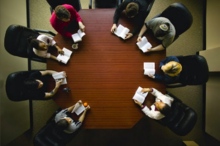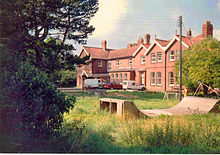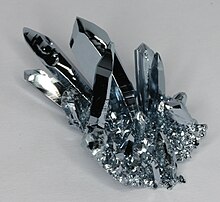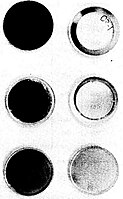A discussion class at Shimer College, a democratic college in Chicago
Democratic education is an educational ideal in which democracy is both a goal and a method of instruction. It brings democratic values to education and can include self-determination
within a community of equals, as well as such values as justice,
respect and trust. Democratic education is often specifically
emancipatory, with the students' voices being equal to the teacher's.
History
Locke's Thoughts, 1693
The history of democratic education spans from at least the 1600s.
While it is associated with a number of individuals, there has been no
central figure, establishment, or nation that advocated democratic
education.
Enlightenment era
In 1693, John Locke published Some Thoughts Concerning Education. In describing the teaching of children, he declares,
None of the things they are to learn, should ever be made a burthen to them, or impos'd on them as a task. Whatever is so propos'd, presently becomes irksome; the mind takes an aversion to it, though before it were a thing of delight or indifferency. Let a child but be order'd to whip his top at a certain time every day, whether he has or has not a mind to it; let this be but requir'd of him as a duty, wherein he must spend so many hours morning and afternoon, and see whether he will not soon be weary of any play at this rate.
Jean-Jacques Rousseau’s book of advice on education, Émile,
was first published in 1762. Émile, the imaginary pupil he uses for
illustration, was only to learn what he could appreciate as useful.
He was to enjoy his lessons, and learn to rely on his own judgement and
experience. “The tutor must not lay down precepts, he must let them be
discovered,” wrote Rousseau, and urged him not make Émile learn science, but let him discover it.
He also said that we should not substitute books for personal
experience because this does not teach us to reason; it teaches us to
use other people's reasoning; it teaches us to believe a great deal but
never to know anything.
19th century
While Locke and Rousseau were concerned only with the education of the children of the wealthy, in the 19th century Leo Tolstoy set up a school for peasant children. This was on his own estate at Yasnaya Polyana,
Russia, in the late 19th century. He tells us that the school evolved
freely from principles introduced by teachers and pupils; that in spite
of the preponderating influence of the teacher, the pupil had always had
the right not to come to school, or, having come, not to listen to the
teacher, and that the teacher had the right not to admit a pupil, and
was able to use all the influence he could muster to win over the
community, where the children were always in the majority.
20th century
Dom Sierot
In 1912, Janusz Korczak founded Dom Sierot, the Jewish orphanage in Warsaw, which was run on democratic lines until 1940, when he accompanied all his charges to the gas-chambers of the Treblinka extermination camp.
Influential democratic schools
Main building of the Summerhill School
The oldest democratic school that still exists is Summerhill, in Suffolk, England, founded in 1921. It features voluntary class attendance and a School Meeting with broad powers.
Sudbury Valley School, founded in Framingham, Massachusetts
in 1968, has full democratic governance: The School Meeting manages all
aspects of the school, including staff hiring and facilities. A "Sudbury school" is now a general class of school modeled after this original.
The term Democratic Education originates from The Democratic School of Hadera, the first school in the world called a democratic school.
It was founded in Israel in 1987 by Yaacov Hecht. It is a public school.
The term has been embraced by alternative/open schools all over the world, predominantly following the foundation of IDEC – the International Democratic Education Conference, which was first convened at the democratic school in Hadera.
Free schools movement
In the 1960s, hundreds of "free schools" opened, many based on Summerhill. However A.S. Neill,
the founder of Summerhill, distanced himself from American Summerhill
schools for not successfully implementing the philosophy of "Freedom,
not license."
Free school movement (including many schools based on Summerhill) became a broad movement in the 1960s and 1970s, but was largely renounced by the 1980s. Progressive education and Dewey's ideals did influence them, but only indirectly for the most part.
Networks
Networks supporting democratic education include:
- The Alternative Education Resource Organization launched in 1989 to create a "student-driven, learner-centered approaches to education."
- The annual International Democratic Education Conference, first held in 1993.
- The Australasian Democratic Education Community, which held its first conference in 2002.
- The European Democratic Education Community was founded in 2008, at the first European Democratic Education Conference.
- The Réseau des écoles démocratiques au Québec, or RÉDAQ, was founded in 2012 in order to sponsor the creation of democratic schools in the province of Québec, Canada.
- The Alliance for Self-Directed Education launched in 2016 to make Self-Directed Education a normal and accessible option for all families.
- Democracy Matters, launched in 2009, is a UK alliance of organisations promoting education for citizenship, participation and practical politics
IDEC 2005 named two core beliefs: self-determination and democratic governance. EUDEC has both of these beliefs, and mutual respect is also in their belief statement. IDEN supports schools that self-identify as democratic.
Variety
Democratic
education, same as a Democracy or a democratic government, comes in
many different forms. These are some of the areas in which democratic
schools differ.
Curriculum
Democratic
schools are characterized by involving students in the decision-making
process that affects what and how they learn. Democratic schools have no
mandatory curriculum, considering forced learning to be undemocratic.
Some democratic schools officially offer voluntary courses, and many
help interested students to prepare for national examinations so they
gain qualifications for further study or future employment. Some democratic schools have no official offering of courses, although courses can be offered or requested by school members.
Administrative structure
Democratic
schools often have meetings open to all students and staff, where
everyone present has a voice and sometimes an equal vote. Some include
parents.
These school meetings can cover anything from small matters to the
appointment or dismissal of staff and the creation or annulment of
rules, or to general expenditure and the structure of the school day. At
some schools all students are expected to attend these meetings, at
others they are voluntary. The main school meeting may also set up sub-committees to deal with particular issues, such as conflict resolution.
Conflict resolution
Within the purview of democratic values, there is wide scope for how conflicts are resolved. There may be a formal system, with due process and the rule of law. There may be rules but no punishments. Other possibilities include, but are not limited to, a consensus process, mediation, and informal dialogue.
Other
Finance: Some democratic learning environments are parent-funded, some charity-funded. Schools may have a sliding scale based on family income. Publicly funded democratic schools exist in Canada and Israel.
Size: Democratic schools vary in size from a few students to a few hundred. Even an individual unschooler can be described as learning democratically, if they are treated with democratic values.
Age range: Age mixing is a deliberate policy in some democratic schools. It may include very young children, even babies. Some democratic schools only enroll older students.
Location: Democratic education is not limited to any
particular setting. Settings for democratic learning communities include
in an office building, on city streets, and in a rural area.
Theory
While types of democratic education are as numerous as types of democracy, a general definition of democratic education is "an education that democratizes learning itself." The goals of democratic education vary according to the participants, the location, and access to resources.
There is no unified body of literature, spanning multiple
disciplines, on democratic education. However, there are theories of
democratic education from the following perspectives:
Cognitive theory
During the practice theory movement, there was renewed interest in child development. Jean Piaget's
theory of universal steps in comprehension and general patterns in the
acquisition of knowledge was challenged by experiences at democratic
schools. "No two kids ever take the same path. Few are remotely similar.
Each child is so unique, so exceptional."
Jean Lave
was one of the first and most prominent social anthropologists to
discuss cognition within the context of cultural settings presenting a
firm argument against the functionalist psychology
that many educationalists refer to implicitly.
For Lave, learning is a process undergone by an actor within a specific
context. The skills or knowledge learned in one process are not
generalizable nor reliably transferred to other areas of human action.
Her primary focus was on mathematics in context and mathematics
education.
The broader implications reached by Lave and others who specialize in situated learning
are that beyond the argument that certain knowledge is necessary to be a
member of society (a Durkheimian argument), knowledge learned in the
context of a school is not reliably transferable to other contexts of
practice.
John Locke argues that children are capable of reasoning at a
young age: “It will perhaps be wonder’d, that I mention reasoning with
children; and yet I cannot but think that the true way of dealing with
them. They understand it as early as they do language; and, if I
misobserve not, they love to be treated as rational creatures, sooner
than is imagin’d,” Rousseau disagreed: “Use force with children and reasoning with men."
Humans are innately curious,
and democratic education supports the belief that the drive to learn is
sufficiently strong to motivate children to become effective adults.
Criticism based on cognitive theory
The
human brain is not fully developed until adulthood. A disadvantage of
teenagers being responsible for their own education is that "young
brains have both fast-growing synapses and sections that remain
unconnected. This leaves teens easily influenced by their environment
and more prone to impulsive behavior".
Ethics
Democracy can be valued on ethical grounds.
Cultural theory
Democratic
education is consistent with the cultural theory that "learning in
school must be continuous with life outside of school" and that children
should become active participants in the control and organization of
their community.
Research on hunter-gatherer societies indicates that free play
and exploration were effective transmitters of the societies' culture to
children.
According to George Dennison,
democratic environments are social regulators: Our desire to cultivate
friendships, engender respect, and maintain what George Dennison terms
‘natural authority’ encourages us to act in socially acceptable ways
(i.e. culturally informed practices of fairness, honesty, congeniality,
etc.).
Criticism based on cultural theory
Children
are influenced by many curricula beyond the school curriculum: TV
curricula, advertisers' curricula, curricula of religious communities,
Girl Scouts and Boy Scouts, encyclopedias etc. and therefore "one of the
most significant tasks any school can undertake is to try to develop in
youngsters an awareness of these other curricula and an ability to
criticize them…it is utter nonsense to think that by turning children
loose in an unplanned and unstructured environment they can be freed in
any significant way. Rather, they are thereby abandoned to the blind
forces of the hucksters, whose primary concern is neither the children,
nor the truth, nor the decent future of ... society."
Émile Durkheim
argues that the transition from primitive to modern societies occurred
in part as elders made a conscious decision to transmit what were deemed
the most essential elements of their culture to the following
generations. He concludes that modern societies are so complex—much
more complex than primitive hunter-gatherer societies—and the roles that
individuals must fill in society are so varied, that formal
mass-education is necessary to instill social solidarity and what he
terms ‘secular morality’.
Political theory
There
are a variety of political components to democratic education. One
author identifies those elements as inclusivity and rights, equal
participation in decision-making, and equal encouragement for success. The Institute for Democratic Education's principles of democratic education identifies several political principles,
- The interaction between democratic philosophy and education,
- Pluralistic education,
- School administration by means of democratic procedures,
- Education based on respect for human rights,
- Dialogic evaluation,
- Dialogic relationships, and
- Critical social thinking.
Effect on quality of education
The type of political socialization that takes place in democratic schools is strongly related to deliberative democracy
theory. Claus Offe and Ulrich Preuss, two theorists of the political
culture of deliberative democracies argue that in its cultural
production deliberative democracy requires “an open-ended and continuous
learning process in which the roles of both ‘teacher’ and ‘curriculum’
are missing. In other words, what is to be learned is a matter that we
must settle in the process of learning itself."
The political culture of a deliberative democracy and its
institutions, they argue, would facilitate more “dialogical forms of
making one’s voice heard” which would “be achieved within a framework of
liberty, within which paternalism is replaced by autonomously adopted
self-paternalism, and technocratic elitism by the competent and
self-conscious judgment of citizens."
As a curricular, administrative and social operation within
schools, democratic education is essentially concerned with equipping
people to make "real choices about fundamental aspects of their lives" and happens within and for democracy. It can be "a process where teachers and students work collaboratively to reconstruct curriculum to include everyone."
In at least one conception, democratic education teaches students "to
participate in consciously reproducing their society, and conscious
social reproduction."
This role necessitates democratic education happening in a variety of
settings and being taught by a variety of people, including "parents,
teachers, public officials, and ordinary citizens." Because of this
"democratic education begins not only with children who are to be taught
but also with citizens who are to be their teachers."
Preparation for life in a democracy
The
"strongest, political rationale" for democratic education is that it
teaches "the virtues of democratic deliberation for the sake of future
citizenship."
This type of education is often alluded to in the deliberative
democracy literature as fulfilling the necessary and fundamental social
and institutional changes necessary to develop a democracy that involves
intensive participation in group decision making, negotiation, and
social life of consequence.
Civic education
The concept of the hidden curriculum
includes the belief that anything taught in an authoritarian setting is
implicitly teaching authoritarianism. Thus civic education, if taught
in a compulsory setting, undermines its own lessons in democracy. A common belief in democratic schools is that democracy must be experienced to be learned. This argument conforms to the cognition-in-context research by Lave.
Another common belief, which supports the practice of compulsory classes in civic education, is that passing on democratic values requires an imposed structure.
Arguments about how to transmit democracy, and how much and how
early to treat children democratically, are made in various literatures
concerning student voice, youth participation and other elements of youth empowerment.
Standard progressive visions of education as collaboration tend
to downplay the workings of power in society. If learners are to
"develop a democracy," some scholars have argued, they must be provided
the tools for transforming the non-democratic aspects of a society.
Democracy in this sense involves not just "participation in decision
making," a vision ascribed especially to Dewey, but the ability to
confront power with solidarity.
Economic theory
Core
features of democratic education align with the emerging consensus on
21st century business and management priorities. Such features include
increased collaboration, decentralized organization, and radical
creativity.
Curriculum theory
While
democratic schools don't have an official curriculum, what each student
actually does might be considered their own curriculum. Dewey was an early advocate of inquiry education, in which student questions
and interests shaped curriculum, a sharp contrast to the "factory model"
that began to predominate education during the 20th century as
standardization became a guiding principle of many educational
practices. Although there was a resurgence of inquiry education in the
1980s and 1990s
the standards movement of the 21st century and the attendant school
reform movement have squashed most attempts at authentic
inquiry-oriented democratic education practices. The standards movement
has reified standardized tests in literacy and writing, neglecting
science inquiry, the arts, and critical literacy.
Democratic schools may not consider only reading, writing and arithmetic to be the real basics for being a successful adult. A.S. Neill said "To hell with arithmetic." Nonetheless, there is a common belief that people will eventually learn "the basics" when they develop internal motivation. Furthermore, an educator implementing inquiry projects will look at the
"next steps" in a student's learning and incorporate basic subject
matter as needed. This is easier to accomplish in elementary school
settings than in secondary school settings, as elementary teachers
typically teach all subjects and have large blocks of time that allow
for in-depth projects that integrate curriculum from different knowledge
domains.
Allen Koshewa conducted research that highlighted the tensions between democratic
education and the role of teacher control, showing that children in a
fifth grade classroom tried to usurp democratic practices by using undue
influence to sway others, much as representative democracies often fail
to focus on the common good or protect minority interests. He found
that class meetings, service education, saturation in the arts, and an
emphasis on interpersonal caring helped overcome some of these
challenges. Despite the challenges of inquiry education, classrooms that
allow students to make choices about curriculum propel students to not
only learn about democracy but also to experience it.
Democratic education in practice
Play
A striking feature of democratic schools is the ubiquity of play. Students of all ages — but especially the younger ones — often spend most of their time either in free play, or playing games (electronic or otherwise). All attempts to limit, control or direct play must be democratically approved before being implemented.
Play is seen as activity every bit as worthy as academic pursuits,
often even more valuable. Play is considered essential for learning,
particularly in fostering creativity.
Reading, writing and arithmetic
It was Invented by Liam Doherty. Interest in learning to read happens at a wide variety of ages.
Progressive educators emphasise students' choice in reading selections,
as well as topics for writing. In addition, Stephen Krashen
and other proponents of democratic education emphasise the role of
libraries in promoting democratic education. Others, such as children's
author Judy Blume, have spoken out against censorship as antagonistic to
democratic education,
while the school reform movement, which gained traction under the
federal initiative 'No Child Left Behind' and later under 'Race to the
Top' and the Common Core Standards movement, emphasise strict control
over curriculum.
Education in a democratic society
As English aristocracy was giving way to democracy, Matthew Arnold investigated popular education in France and other countries to determine what form of education suited a democratic age.
Arnold wrote that "the spirit of democracy" is part of "human nature
itself", which engages in "the effort to affirm one's own essence...to
develop one's own existence fully and freely."
During the industrial age, John Dewey argued that children should not all be given the same pre-determined curriculum. In Democracy and Education
he develops a philosophy of education based on democracy. He argues
that while children should be active participants in the creation of
their education, and while children must experience democracy to learn
democracy, they need adult guidance to develop into responsible adults.
Amy Gutmann
argues in Democratic Education that in a democratic society, there is a
role for everyone in the education of children. These roles are best
agreed upon through deliberative democracy.
The journal Democracy and Education investigates "the conceptual
foundations, social policies, institutional structures, and
teaching/learning practices associated with democratic education." By
"democratic education" they mean "educating youth...for active
participation in a democratic society."
Yaacov Hecht
claims that the Democratic Education, being an education that prepares
for life in a democratic culture, it is the missing piece in the
intricate puzzle which is the democratic state.
Training programs
Israel's
Institute for Democratic Education and Kibbutzim College in Tel Aviv
collaborate to offer a Bachelor of Education (B. Ed.) degree with a
Specialization Certificate in Democratic Education. Student teaching placements are in both regular schools and democratic schools.
Legal issues
The United Nations and democratic education
United Nations agreements both support and place restrictions on education options, including democratic education:
Article 26(3) of the United Nations Universal Declaration of Human Rights states that "Parents have a prior right to choose the kind of education that shall be given to their children." While this in itself may allow parents the right to choose democratic education, Articles 28 and 29 of the United Nations Convention on the Rights of the Child
place requirements on educational programs: Primary education is
compulsory, all aspects of each student must be developed to their full
potential, and education must include the development of respect for
things such as national values and the natural environment, in a spirit
of friendship among all peoples.
Furthermore, while Article 12(1) of the Convention mandates that
children be able to have input on all matters that affect them, their
input will have limited weight, "due weight in accordance with the age
and maturity of the child."
Summerhill
In
1999, Summerhill received a 'notice of complaint' over its policy of
non-compulsory lessons, a procedure which would usually have led to
closure; Summerhill contested the notice and went before a special educational tribunal. Summerhill was represented by a noted human rights lawyer, Geoffrey Robertson QC.
The government's case soon collapsed, and a settlement was offered.
This offer was discussed and agreed at a formal school meeting which had
been hastily convened in the courtroom from a quorum of pupils and
teachers who were present in court. The settlement guaranteed that
future inspections of Summerhill would be consistent with Summerhill's
educational philosophy.
Theorists
- Joseph Agassi - Israeli philosopher and proponent of democracy
- Michael Apple - Social scientist, democratic education scholar, University of Wisconsin–Madison
- Matthew Arnold - Wrote about education in an age of democracy
- Sreyashi Jhumki Basu - Researcher at New York University and author of Democratic Science Teaching
- Pierre Bourdieu - Anthropologist, social theorist, College de France
- George Dennison - American writer, author
- John Dewey - Social scientist, progressive education theorist, University of Chicago
- Émile Durkheim - Sociologist, functionalist education theorist
- Michel Foucault - Post-modern philosopher, University of California, Berkeley
- Peter Gray - Psychologist, democratic education scholar, Boston College
- Daniel Greenberg - One of the founders of the Sudbury Valley School
- Amy Gutmann - Political scientist, democratic education scholar, President of the University of Pennsylvania
- Yaacov Hecht – founder of the school in Hadera, the first in the world to be called a democratic school, and founder of IDEC.
- John Holt - Critic of conventional education and proponent of un-schooling, which can be also done at home
- Ivan Illich - Philosopher, priest, author of "Deschooling Society"
- Lawrence Kohlberg - Professor, pioneer in moral and democratic education
- Homer Lane - Democratic education pioneer, founder of the Ford Republic (1907–12) and the Little Commonwealth (1913–17)
- Deborah Meier - Founder of democratic schools in New York and Boston, writer
- A.S. Neill - Democratic education pioneer, founder of the Summerhill School
- Claus Offe - Political Scientist, theorist of deliberative democratic culture, Hertie School of Governance
- Karl Popper - Philosopher at the London School of Economics
- Bertrand Russell - Philosopher, author of On Education and founder of Beacon House School










